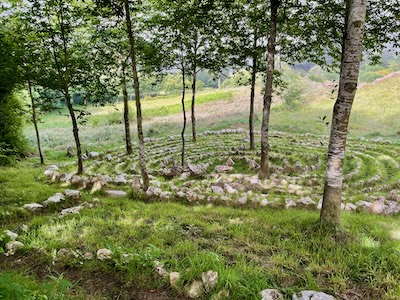One visual image, first posted in 2022, provides the most powerful message about the importance of “We” over “I.” It comes from Max Roser’s website, “OurWorldinData.org.”
Roser has used data over time to show that, contrary to how we feel the world is, human life has been getting better for decades.
Yes, I know. Hard to believe.
But in graphic after graphic, often animated over time, his website shows improvements in life expectancy, income and health. And this is happening despite the regular parade of human monsters like Hitler, Stalin, Pol Pot and so many other despots who are responsible for deaths numbering in the hundreds of thousands to the millions.
Did I mention Vladimir Putin?
The Hourglass of Humanity
But let’s forget names. Let’s focus on the big picture.
- How many humans have there ever been?
- Where do we stand in the long stream of human life?
Imagine an hourglass. In the hourglass, each grain of sand represents 10 million human lives. With 140 million children born every year, 14 grains of sand enter the hourglass each year, falling into the 795 grains of sand that represent the 7.95 billion humans alive today. You can see the image at this link: Future-as-triangles-of-an-hour-glass-01
Each year 60 million people die, so 6 grains of sand fall to the bottom of the hourglass. They add to the 10,900 grains of sand that have accumulated at the bottom, representing the 109 billion people who have already lived and died.
Of the 109 billion people who preceded us, it is estimated that half lived in the last 2,000 years, that half of all those who lived and died in pre-modern times were children and that only 9 billion had lived and died before the agricultural revolution.
You and I are fantastically fortunate to be anywhere among the people alive today. We benefit from all those who have gone before us. From the slow development of speech and language. From the creation of music. From the invention and development, over centuries, of mathematics. From the discovery of materials and the making of all manner of objects that make our lives better.
We benefit from a multitude of things, most of which we, as individuals, don’t understand. Our debt is simply staggering and we seldom, if ever, see it or acknowledge it.
A Closer Look at a Grain of Sand
Recall that each grain of sand represents 10 million people. In 2024 about 3.62 million babies were born in the United States. That means it took nearly three years (33.15 months to be precise) for our collective reproductive efforts (or cheering on of same) to produce just one of the 140 grains produced worldwide each year.
Think about this at all and there is no way, absolutely no way, that any of us can put “I” before “We.”
Being Just Like Teenagers
It is common for adults to look at teenagers and remark on how self-centered they are. Or on how important they think their wants and needs are compared to, well, just about anything. The reality is that most of us adults are just better at hiding our commitment to “I” over “We.”
As individuals, we have two important tasks. The first is to recognize when we’ve cleverly hidden our “I” concern in a smoke screen of “We.” That’s hard work, but worth doing.
The second is to become sharp observers of others who promote “I” as “We.” That’s a lot easier. For the easiest practice, I suggest listening to virtually anyone in politics, left or right.
The Benefit of Discovering “We”
I’m still working on this. I probably always will be. But I can see a great benefit from putting “We” before “I.” It is personal freedom.
Any step toward “We” is a step away from feeling overly responsible for events in the world – yet millions of Americans (not to mention other humans) feel personally responsible for things that happen thousands of miles away. In real life we can only hope to take responsibility for things we can do something about, like being polite and kind, now.
That, ironically, turns out to be real power.
Related columns:
Scott Burns, “The Incredible Expanding Retirement,” 7/20/1999: https://scottburns.com/the-incredible-expanding-retirement/
Scott Burns, “Sandbagging the Pursuit of Happiness,” 9/10/2022: https://scottburns.com/sandbagging-the-pursuit-of-happiness/
Scott Burns, “The Next Top 1 Percent,” 2/26/2023: https://scottburns.com/living-beyond-90/
Scott Burns, “The Supreme Grand Poohbah Saves Social Security,” 5/4/2025: https://scottburns.com/the-supreme-grand-poohbah-saves-social-security/
Sources and References:
Max Roser, “The future is vast – what does this mean for our own life?” 3/15/2022: https://ourworldindata.org/the-future-is-vast
Max Roser: “Our World in Data” on YouTube: https://www.youtube.com/watch?v=HQSQ16dntbc
Max Roser: On Education: https://www.youtube.com/watch?v=qTGk5vEcMHg
Steven Pinker: “Is the world getting better or worse? A look at the numbers,” 4/2018 (using Roser data): https://www.ted.com/talks/steven_pinker_is_the_world_getting_better_or_worse_a_look_at_the_numbers/transcript
This information is distributed for education purposes, and it is not to be construed as an offer, solicitation, recommendation, or endorsement of any particular security, product, or service.
Photo: Scott Burns, July 1, 2024: A Meditation Circle on the Camino de Santiago
(c) Scott Burns, 2025
4 thoughts on “Seeing “We” Before “I””
Comments are closed.

Followed the column for years but just discovered the website.
Hi Bill,
Welcome to what I hope will be a refuge of calm, fact and lucid observation-based reporting, far from the emotive but fact-free content of social media!
Scott,
Just back from a cruise and catching up (as well as learning to check your website rather than DMN!).
Something I often tell my Sister: you cannot allow the World’s problems (that you have ZERO control/influence over) to affect your attitude. Are events tragic/sad? Yep but focus on local items that you can influence….
great article to remind all.
Bill
Thanks!